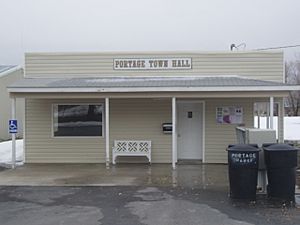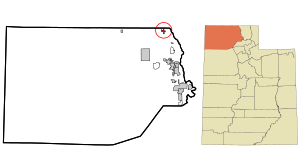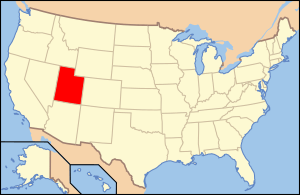Portage, Utah facts for kids
Quick facts for kids
Portage, Utah
|
|
|---|---|

Town Hall
|
|

Location in Box Elder County and the state of Utah
|
|

Location of Utah in the United States
|
|
| Country | United States |
| State | Utah |
| County | Box Elder |
| Settled | 1867 |
| Incorporated | 1922 |
| Named for | Portage County, Ohio |
| Area | |
| • Total | 2.55 sq mi (6.61 km2) |
| • Land | 2.55 sq mi (6.61 km2) |
| • Water | 0.00 sq mi (0.00 km2) |
| Elevation | 4,465 ft (1,361 m) |
| Population
(2010)
|
|
| • Total | 245 |
| • Estimate
(2019)
|
273 |
| • Density | 106.89/sq mi (41.27/km2) |
| Time zone | UTC-7 (Mountain (MST)) |
| • Summer (DST) | UTC-6 (MDT) |
| ZIP code |
84331
|
| Area code(s) | 435 |
| FIPS code | 49-61590 |
| GNIS feature ID | 2412497 |
Portage is a small town located in Box Elder County, Utah, in the United States. In 2010, about 245 people lived there. The town got its name from Lorenzo Snow, an important leader of the Church of Jesus Christ of Latter-day Saints. He named it "Portage" because it was also the name of the county where he was born in Ohio.
Contents
Where is Portage, Utah?
Portage is found in the northeast part of Box Elder County. Its northern edge is right on the border between Utah and Idaho. The town is located in the Malad Valley. It sits west of Interstate 15, a major highway.
According to the United States Census Bureau, Portage covers about 2.55 square miles (6.61 square kilometers) of land. There is no water area within the town limits.
What is the Climate Like in Portage?
Portage experiences a humid continental climate. This means the town has big changes in temperature throughout the year. Summers are usually warm to hot, and sometimes humid. Winters are cold, and can sometimes be very cold.
Who Lives in Portage?
| Historical population | |||
|---|---|---|---|
| Census | Pop. | %± | |
| 1870 | 158 | — | |
| 1880 | 462 | 192.4% | |
| 1890 | 545 | 18.0% | |
| 1900 | 579 | 6.2% | |
| 1910 | 499 | −13.8% | |
| 1920 | 456 | −8.6% | |
| 1930 | 331 | −27.4% | |
| 1940 | 342 | 3.3% | |
| 1950 | 254 | −25.7% | |
| 1960 | 189 | −25.6% | |
| 1970 | 144 | −23.8% | |
| 1980 | 196 | 36.1% | |
| 1990 | 218 | 11.2% | |
| 2000 | 257 | 17.9% | |
| 2010 | 245 | −4.7% | |
| 2019 (est.) | 273 | 11.4% | |
| U.S. Decennial Census | |||
In the year 2000, there were 257 people living in Portage. These people lived in 75 different households, and 62 of those were families. The town had about 112.6 people per square mile.
Most of the people in Portage were White, making up almost 99% of the population. A small number, about 1.17%, were from two or more races. About 5.45% of the population identified as Hispanic or Latino.
Households and Families
Out of the 75 households in 2000, nearly half (46.7%) had children under 18 living there. Most households (73.3%) were married couples living together. A small number (4.0%) had a female head of household without a husband present.
The average household in Portage had about 3.43 people. The average family size was slightly larger, with about 3.84 people.
Age and Income in Portage
The population in Portage was spread across different age groups. About 39.7% of the people were under 18 years old. About 10.9% were 65 years old or older. The average age of people in Portage was 30 years.
In 2000, the average income for a household in Portage was $43,125 per year. For families, the average income was $48,333. The average income per person in the town was $13,257. A small portion of families (1.7%) and individuals (8.7%) lived below the poverty line.
Ancestry of Residents
Many residents of Portage have ancestors from different parts of Europe. The most common ancestries include English (28.8%), Danish (16.3%), and German (16.3%). Other ancestries include Scottish (10.9%), Norwegian (7.4%), and Welsh (5.1%).
See also
 In Spanish: Portage (Utah) para niños
In Spanish: Portage (Utah) para niños

